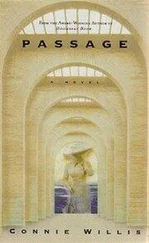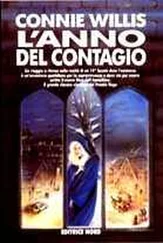The Society had called him an alarmist, which just goes to show you how much things can change.
Well, he was an alarmist, wasn’t he? The grizzly bear isn’t extinct in the wild—it’s Colorado’s biggest tourist draw, and there are so many whooping cranes Texas is talking about limited hunting.
In all the uproar, the zoo had ceased to exist, and the animals all went to an even more comfortable prison in Sun City—sixteen acres of savannah land for the zebras and lions, and snow manufactured daily for the polar bears.
They hadn’t really been cages, in spite of what the zoo director said. The old capybara enclosure, which was the first thing inside the gate, was a nice little meadow with a low stone wall around it. A family of prairie dogs had taken up residence in the middle of it.
I went back to the gate and looked down at the Winnebago. The family circled the Winnebago, the man bending down to look underneath the body. One of the kids was hanging off the ladder at the back of the RV. The ferret was nosing around the front wheel Jake Ambler had so carefully scrubbed down, looking like it was about ready to lift its leg, if ferrets do that.
The kid yanked on its leash and then picked it up in his arms. The mother said something to him. Her nose was sunburned.
Katie’s nose had been sunburned. She had had that white cream on it that skiers used to use. She had been wearing a parka and jeans and bulky pink and white moon boots that she couldn’t run in, but she still made it to Aberfan before I did. I pushed past her and knelt over him.
“I hit him,” she said bewilderedly. “I hit a dog.”
“Get back in the jeep, damn it!” I shouted at her.
I stripped off my sweater and tried to wrap him in it. “We’ve got to get him to the vet.”
“Is he dead?” Katie said, her face as pale as the cream on her nose.
“No!” I had shouted. “No, he isn’t dead!”
The mother turned and looked up toward the zoo, her hand shading her face. She caught sight of the camera, dropped her hand, and smiled, a toothy, impossible smile. People in the public eye are the worst, but even people having a snapshot taken close down somehow, and it isn’t just the phony smile. It’s as if that old superstition is true and cameras do really steal the soul.
I pretended to take her picture and then lowered the camera. The zoo director had put up a row of tombstone-shaped signs in front of the gate, one for each endangered species. They were covered with plastic, which hadn’t helped much.
I wiped the streaky dust off the one in front of me. “Canis latrans,” it said, with two green stars after it. “Coyote. North American wild dog. Due to large-scale poisoning by ranchers, who saw it as a threat to cattle and sheep, the coyote is nearly extinct in the wild.” Underneath there was a photograph of a ragged coyote sitting on its haunches and an explanation of the stars. Blue—endangered species. Yellow—endangered habitat. Red—extinct in the wild.
After Misha died, I had come out here to photograph the dingo and the coyotes and the wolves, but they were already in the process of moving the zoo, so I couldn’t get any pictures, and it probably wouldn’t have done any good. The coyote in the picture had faded to a greenish yellow and its yellow eyes were almost white, but it stared out of the picture looking as hearty and unconcerned as Jake Ambler, wearing its camera face.
The mother had gone back to the bug and was herding the kids inside. Mr. Ambler walked the father back to the car, shaking his shining bald head, and the man talked some more, leaning on the open door, and then got in and drove off. I walked back down.
If he was bothered by the fact that they had only stayed ten minutes and that, as far as I had been able to see, no money had changed hands, it didn’t show in his face. He led me around to the side of the RV and pointed to a chipped and faded collection of decals along the painted bar of the W. “These here are the states we’ve been in.” He pointed to the one nearest the front. “Every state in the Union, plus Canada and Mexico. Last state we were in was Nevada.”
Up this close it was easy to see where he had painted out the name of the original RV and covered it with the bar of red. The paint had the dull look of inauthenticity. He had covered up the words “Open Road” with a burnt-wood plaque that read, “The Amblin’ Amblers.”
He pointed at a bumper sticker next to the door that said “I got lucky in Vegas at Caesar’s Palace” and had a picture of a naked showgirl. “We couldn’t find a decal for Nevada. I don’t think they make them anymore. And you know something else you can’t find? Steering wheel covers. You know the kind. That keep the wheel from burning your hands when it gets hot?”
“Do you do all the driving?” I asked.
He hesitated before answering, and I wondered if one of them didn’t have a license. I’d have to look it up in the lifeline.
“Mrs. Ambler spells me sometimes, but I do most of it. Mrs. Ambler reads the map. Damn maps nowadays are so hard to read. Half the time you can’t tell what kind of road it is. They don’t make them like they used to.”
We talked for a while more about all the things you couldn’t find a decent one of anymore and the sad state things had gotten in generally, and then I announced I wanted to talk to Mrs. Ambler, got the vidcam and the eisenstadt out of the car, and went inside the Winnebago.
She still had the dish towel in her hand, even though there couldn’t possibly be space for that many dishes in the tiny RV. The inside was even smaller than I had thought it would be, low enough that I had to duck and so narrow I had to hold the Nikon close to my body to keep from hitting the lens on the passenger seat. It felt like an oven inside, and it was only nine o’clock in the morning.
I set the eisenstadt down on the kitchen counter, making sure its concealed lens was facing out. If it would work anywhere, it would be here. There was basically nowhere for Mrs. Ambler to go that she could get out of range. There was nowhere I could go, either, and sorry, Ramirez, there are just some things a live photographer can do better than a preprogrammed one, like stay out of the picture.
“This is the galley,” Mrs. Ambler said, folding her dish towel and hanging it from a plastic ring on the cupboard below the sink with the cross-stitch design showing.
It wasn’t a rooster after all. It was a poodle wearing a sunbonnet and carrying a basket. “Shop on Wednesday,” the motto underneath said.
“As you can see, we have a double sink with a hand-pump faucet. The refrigerator is LP-electric and holds four cubic feet. Back here is the dinette area. The table folds up into the rear wall, and we have our bed. And this is our bathroom.”
She was as bad as her husband. “How long have you had the Winnebago?” I said to stop the spiel. Sometimes, if you can get people talking about something besides what they intended to talk about, you can disarm them into something like a natural expression.
“Nineteen years,” she said, lifting up the lid of the chemical toilet. “We bought it in 1989. I didn’t want to buy it—I didn’t like the idea of selling our house and going gallivanting off like a couple of hippies, but Jake went ahead and bought it, and now I wouldn’t trade it for anything. The shower operates on a forty-gallon pressurized water system.”
She stood back so I could get a picture of the shower stall, so narrow you wouldn’t have to worry about dropping the soap. I dutifully took some vidcam footage.
“You live here full-time, then?” I said, trying not to let my voice convey how impossible that prospect sounded. Ramirez had said they were from Minnesota. I had assumed they had a house there and only went on the road for part of the year.
Читать дальше












